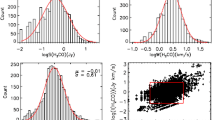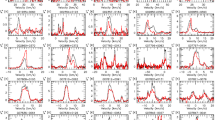Abstract
We observed the H2CO(110–111) absorption lines and H110α radio recombination lines (RRL) toward 180 NH3 sources using the Nanshan 25-m radio telescope. In our observation, 138 sources were found to have H2CO lines and 36 have H110α RRLs. Among the 138 detected H2CO sources, 38 sources were first detected. The detection rates of H2CO have a better correlation with extinction than with background continuum radiation. Line center velocities of H2CO and NH3 agree well. The line width ratios of H2CO and NH3 are generally larger than unity and are similar to that of 13CO. The correlation between column densities of H2CO and extinction is better than that between NH3 and extinction. These line width relation and column density relation indicate H2CO is distributed on a larger scale than that of NH3, being similar to the regions of 13CO. The abundance ratios between NH3 and H2CO were found to be different in local clouds and other clouds.








Similar content being viewed by others
Notes
CLASS is a part of GILDAS package, developed by IRAM (Institute de Radioastronomie Millimétrique). http://www.iram.fr/IRAMFR/GILDAS/.
References
Barranco, J.A., Goodman, A.A.: Astrophys. J. 504, 207 (1998)
Bohlin, R.C., Savage, B.D., Drake, J.F.: Astrophys. J. 224, 132 (1978)
Caswell, J.L., Haynes, R.F.: Astron. Astrophys. 171, 261 (1987)
Churchwell, E., Walmsley, C.M., Cesaroni, R.: Astron. Astrophys. Suppl. Ser. 83, 119 (1990)
Darling, J., Zeiger, B.: Astrophys. J. Lett. 749, 33 (2012)
Dobashi, K.: Publ. Astron. Soc. Jpn. 63, 1 (2011)
Downes, D., Wilson, T.L., Bieging, J., Wink, J.: Astron. Astrophys. Suppl. Ser. 40, 379 (1980)
Du, Z.M., Zhou, J.J., Esimbek, J., Han, X.H., Zhang, C.P.: Astron. Astrophys. 532, 127 (2011)
Evans, N.J. II, Morris, G., Sato, T., Zuckerman, B.: Astrophys. J. 196, 433 (1975)
Garrison, B.J., Lester, W.A. Jr., Miller, W.H., Green, S.: Astrophys. J. Lett. 200, 175 (1975)
Goodman, A.A., Pineda, J.E., Schnee, S.L.: Astrophys. J. 692, 91 (2009)
Han, X.-H., Zhou, J.-J., Esimbek, J., Wu, G., Gao, M.-F.: Res. Astron. Astrophys. 11, 156 (2011)
Harju, J., Walmsley, C.M., Wouterloot, J.G.A.: Astron. Astrophys. Suppl. Ser. 98, 51 (1993)
Heiles, C.: Astrophys. J. 183, 441 (1973)
Henkel, C., Walmsley, C.M., Wilson, T.L.: Astron. Astrophys. 82, 41 (1980)
Ho, P.T.P., Townes, C.H.: Annu. Rev. Astron. Astrophys. 21, 239 (1983)
Jackson, J.M., Rathborne, J.M., Shah, R.Y., Simon, R., Bania, T.M., Clemens, D.P., Chambers, E.T., Johnson, A.M., Dormody, M., Lavoie, R., Heyer, M.H.: Astrophys. J. Suppl. Ser. 163, 145 (2006)
Kirk, H., Johnstone, D., Tafalla, M.: Astrophys. J. 668, 1042 (2007)
Liszt, H.S., Lucas, R., Pety, J.: Astron. Astrophys. 448, 253 (2006)
MacDonald, G.H., Little, L.T., Brown, A.T., Riley, P.W., Matheson, D.N., Felli, M.: Mon. Not. R. Astron. Soc. 195, 387 (1981)
Mangum, J.G., Wootten, A.: Astrophys. J. Suppl. Ser. 89, 123 (1993)
Mangum, J.G., Darling, J., Menten, K.M., Henkel, C.: Astrophys. J. 673, 832 (2008)
Mangum, J.G., Darling, J., Henkel, C., Menten, K.M.: Astrophys. J. 766, 108 (2013)
McGehee, P.M.: In: Reipurth, B. (ed.) Star Formation and Molecular Clouds at High Galactic Latitude, p. 813 (2008)
Mebold, U., Heithausen, A., Reif, K.: Astron. Astrophys. 180, 213 (1987)
Myers, P.C., Benson, P.J.: Astrophys. J. 266, 309 (1983)
Nash, A.G.: Astrophys. J. Suppl. Ser. 72, 303 (1990)
Padoan, P., Cambrésy, L., Juvela, M., Kritsuk, A., Langer, W.D., Norman, M.L.: Astrophys. J. 649, 807 (2006)
Pipenbrink, A., Wendker, H.J.: Astron. Astrophys. 191, 313 (1988)
Ridge, N.A., Di Francesco, J., Kirk, H., Li, D., Goodman, A.A., Alves, J.F., Arce, H.G., Borkin, M.A., Caselli, P., Foster, J.B., Heyer, M.H., Johnstone, D., Kosslyn, D.A., Lombardi, M., Pineda, J.E., Schnee, S.L., Tafalla, M.: Astron. J. 131, 2921 (2006)
Scalise, E. Jr., Schaal, R.E., Bakor, Y., Vilas Boas, J.W.S., Myers, P.C.: Astron. J. 86, 1939 (1981)
Schreyer, K., Henning, T., Koempe, C., Harjunpaeae, P.: Astron. Astrophys. 306, 267 (1996)
Snyder, L.E., Buhl, D., Zuckerman, B., Palmer, P.: Phys. Rev. Lett. 22, 679 (1969)
Sridharan, T.K., Beuther, H., Schilke, P., Menten, K.M., Wyrowski, F.: Astrophys. J. 566, 931 (2002)
Sun, X.H., Han, J.L., Reich, W., Reich, P., Shi, W.B., Wielebinski, R., Fürst, E.: Astron. Astrophys. 463, 993 (2007)
Tang, X.D., Esimbek, J., Zhou, J.J., Wu, G., Ji, W.G., Okoh, D.: Astron. Astrophys. 551, 28 (2013)
Tang, X.D., Esimbek, J., Zhou, J.J., Wu, G., Okoh, D.: arXiv:1402.5471 (2014)
Townes, C.H., Cheung, A.C.: Astrophys. J. Lett. 157, 103 (1969)
Tucker, K.D., Tomasevich, G.R., Thaddeus, P.: Astrophys. J. 169, 429 (1971)
Ungerechts, H., Winnewisser, G., Walmsley, C.M.: Astron. Astrophys. 157, 207 (1986)
Ungerechts, H., Bergin, E.A., Goldsmith, P.F., Irvine, W.M., Schloerb, F.P., Snell, R.L.: Astrophys. J. 482, 245 (1997)
van der Tak, F.F.S., Black, J.H., Schöier, F.L., Jansen, D.J., van Dishoeck, E.F.: Astron. Astrophys. 468, 627 (2007)
Vanden Bout, P.A., Snell, R.L., Wilson, T.L.: Astron. Astrophys. 118, 337 (1983)
Walmsley, C.M., Ungerechts, H.: Astron. Astrophys. 122, 164 (1983)
Walsh, A.J., Myers, P.C., Di Francesco, J., Mohanty, S., Bourke, T.L., Gutermuth, R., Wilner, D.: Astrophys. J. 655, 958 (2007)
Wienen, M., Wyrowski, F., Schuller, F., Menten, K.M., Walmsley, C.M., Bronfman, L., Motte, F.: Astron. Astrophys. 544, 146 (2012)
Wu, J., Evans, N.J. II, Gao, Y., Solomon, P.M., Shirley, Y.L., Vanden Bout, P.A.: Astrophys. J. Lett. 635, 173 (2005)
Young, K.E., Lee, J.-E., Evans, N.J. II, Goldsmith, P.F., Doty, S.D.: Astrophys. J. 614, 252 (2004)
Zhang, C.P., Esimbek, J., Zhou, J.J., Wu, G., Du, Z.M.: Astrophys. Space Sci. 337, 283 (2012)
Acknowledgements
We thank all the staff of Nanshan Observatory for observations. This work was funded by The National Natural Science foundation of China under grant 10778703 and partly supported by China Ministry of Science and Technology under State Key Development Program for Basic Research (2012CB821800) and the National Natural Science foundation of China under grant 11373062, 11303081, and 10873025.
Author information
Authors and Affiliations
Corresponding author
Appendices
Appendix A: Simulation of blended H2CO HFS
The optical depth of all the HFS is simply assumed to be a superposition of N components,
where αj and vj are the intensity and velocity of the jth HFS component, and Δvint is the intrinsic line width. The αj and vj data of H2CO(110–111) HFS components were got from (Tucker et al. 1971). Because the optical depth of H2CO(110–111) in most cases is far less than 1, we assume that the intensity is proportional to the opacity. So the spectra line profile is the same as τ(v).
Spectra for Δvint between 0.43 to 8.69 at intervals of 0.43 km/s (7 KHz to 140 KHz at intervals of 7 KHz) were calculated using Eq. (A.1). Then single Gaussian fittings were made to get the blended line width. The simulated spectra are shown in Fig. 14 and the fitting results are listed in Table 4. The ratios between blended and unblended line widths are plotted in Fig. 9. Because most of our observed line widths are larger than 1 km s−1, this HFS blending effect would not make much difference as regards our sources.
Appendix B: Non-LTE radiative transfer of H2CO
To absorb the CMB radiation as observed, the H2CO 110–111 transition must have an excitation temperature lower than CMB. The different cross sections of transitions in collision are considered to be the ones most likely to generate such a low excitation temperature (Townes and Cheung 1969; Garrison et al. 1975; Evans et al. 1975). The excitation of H2CO should be treated with a non-LTE method, because the LTE approximation would cause an excitation temperature above CMB. We used the Radex Non-LTE molecular radiative transfer code (van der Tak et al. 2007) to calculate the excitation of H2CO. The predicted line brightness temperature (TL) and excitation temperature (Tex) were calculated from the input H2 number density (n[H2]), the H2CO column density (N[H2CO]), the background brightness temperature (Tbg), and the kinetic temperature (Tkin), where Tbg is the background brightness temperature, which is equal to TC+TCMB in Eq. (2).
The result shows that the competition between collision and background radiation dominates the excitation process of H2CO. Figure 10 shows Tex vs. Tbg under different Tkin and n[H2]. Under both low n[H2] and high n[H2] conditions, Tex is less sensitive to Tkin at high Tkin (Tkin>20 K). A similar relation between Tex and Tkin was obtained by Darling and Zeiger (2012) in high redshift galaxies. At low n[H2], collisions are insufficient. Then the background radiation dominates the level populations and the excitation temperature of H2CO almost follows the variation of Tbg, i.e. Tex≈Tbg−Constant, as is shown in Fig. 10(a). This may contribute to the less clear relation between the detection rate and TC in Fig. 1(b). At high n[H2], collisions dominate the level populations and the excitation temperature keeps almost constant over the whole Tbg range.
The possible n[H2] values of H2CO 6-cm lines are considered to be 103<n[H2]<105 (cm−3) (Evans et al. 1975; Henkel et al. 1980). The exact value of n[H2], which in principle can be derived through the relative intensity of 110–111 (6 cm) and 211–212 (2 cm) (Henkel et al. 1980; Mangum et al. 2008), is unknown because only the 6-cm lines were observed. But in that n[H2] interval, the n[H2] seems not to influence the N[H2CO] too much, as the contours in that region in Fig. 11(a) are almost parallel to the horizontal axis. To find the potential uncertainty introduced by the unknown n[H2], we calculated the N[H2CO] under the assumptions that n[H2]=102, 103, 104, and 105 (cm−3), respectively. The histogram distributions of the column densities are plotted in Fig. 11(b). The column density distributions of n[H2]=103, 104, and 105 (cm−3) are almost the same, and that of n[H2]=102 (cm−3) is about one order larger than the others. We also plotted the histogram distribution of column densities under the assumption that Tex=1.7 K in Sect. 3. The N[H2CO] distribution of Tex=1.7 K is about half an order larger than that of 103<n[H2]<105 (cm−3).
(a) Contours of TL in log(n[H2])−log(N[H2CO]) space. The figure presents a map of calculated TL in log(n[H2])−log(N[H2CO]) space. For each source, one contour on which TL is equal to the observed TMB is drawn. (b) Histogram of N[H2CO] under different assumptions: n[H2]=102, 103, 104, 105 (cm−3), and Tex=1.7 K
Rights and permissions
About this article
Cite this article
Yuan, Y., Esimbek, J., Zhou, J.J. et al. H2CO and H110α observations towards NH3 sources. Astrophys Space Sci 352, 521–545 (2014). https://doi.org/10.1007/s10509-014-1922-y
Received:
Accepted:
Published:
Issue Date:
DOI: https://doi.org/10.1007/s10509-014-1922-y














